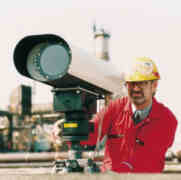UV Beam Identifies Invisible Air Pollutants

The Falcon system scans for up to 20 toxic substances
Air pollution used to be something you could see and smell. But as air quality standards have tightened, the air over most industrial sites, airports and cities has gradually cleared. Nevertheless, invisible toxic agents such as ethyl benzene, butadiene and styrene continue to pose risks to public health. With a view to detecting and quantifying these agents, Siemens Environmental Systems Limited in Poole, England has introduced UV Falcon. The system consists of a transmitter that projects a UV (ultraviolet) beam generated by a deuterium lamp across an open path of between 10 – 200 meters to a receiver. Based on the principle that gases have characteristic “spectral fingerprints,” or in other words absorption lines in the 200 – 300 nanometer UV range, the system uses a patented fourier transform spectrometer to scan the beam for up to 20 toxic and environmentally harmful gases in low parts per billion levels. Although the majority of applications are for fixed installations, the Environment Agency of England and Wales recently purchased a Falcon system for rapid mobile deployment.
Media Contact
All latest news from the category: Ecology, The Environment and Conservation
This complex theme deals primarily with interactions between organisms and the environmental factors that impact them, but to a greater extent between individual inanimate environmental factors.
innovations-report offers informative reports and articles on topics such as climate protection, landscape conservation, ecological systems, wildlife and nature parks and ecosystem efficiency and balance.
Newest articles

Innovative 3D printed scaffolds offer new hope for bone healing
Researchers at the Institute for Bioengineering of Catalonia have developed novel 3D printed PLA-CaP scaffolds that promote blood vessel formation, ensuring better healing and regeneration of bone tissue. Bone is…

The surprising role of gut infection in Alzheimer’s disease
ASU- and Banner Alzheimer’s Institute-led study implicates link between a common virus and the disease, which travels from the gut to the brain and may be a target for antiviral…

Molecular gardening: New enzymes discovered for protein modification pruning
How deubiquitinases USP53 and USP54 cleave long polyubiquitin chains and how the former is linked to liver disease in children. Deubiquitinases (DUBs) are enzymes used by cells to trim protein…



